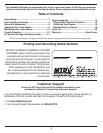
9
4
Operating
Your Lawn
Mower
WARNING
The operation of
any lawn mower
can result in foreign
objects being thrown
into the eyes, which
can damage your
eyes severely.
Always wear safety
glasses while operat-
ing the mower, or
while performing
any adjustments or
repairs on it.
Be sure no one other
than the operator is
standing near the
lawn mower while
starting engine or
operating mower.
Never run engine in-
doors or in enclosed,
poorly venti-
lated areas. Engine
exhaust contains
carbon monoxide, an
odorless and deadly
gas. Keep hands,
feet, hair and loose
clothing away from
any moving parts
on engine and lawn
mower.
WARNING: The operation of any lawn mower
can result in foreign objects being thrown
into the eyes, which can damage your eyes severely.
Always wear safety glasses while operating the
mower, or while performing any adjustments or
repairs on it.
Starting Engine
WARNING: Be sure no one other than the op-
erator is standing near the lawn mower while
starting engine or operating mower. Never
run engine indoors or in enclosed, poorly ventilated
areas. Engine exhaust contains carbon monoxide, an
odorless and deadly gas. Keep hands, feet, hair and
loose clothing away from any moving parts on engine
and lawn mower.
WARNING: Always keep hands and feet clear
of equipment moving parts. Do not use a pres-
surized starting fluid. Vapors are flammable.
1. Pull out the choke knob located on the left side of the
upper handle. See Figure 4-2.
NOTE: Use of the choke is not necessary if the engine is
warm or the air temperature is high.
2. Standing behind the mower, depress the blade control
and hold it against the upper handle.
3. Pull the starter grip lightly until resistance is felt,
then pull rapidly to overcome compression, prevent
kickback and start engine. Repeat if necessary. See
Figure 4-2 .
IMPORTANT: Do not allow the starter grip to snap
back against the rope guide. Return it gently to prevent
damage to the starter.
4. When engine warms up, push in the choke knob. See
Figure 4-2.
Stopping Engine
1. Release blade control to stop the engine and blade.
Using Your Lawn Mower
WARNING: Never operate your mower without
either the rear door or the entire grass catcher
assembly firmly secured.
Be sure lawn is clear of stones, sticks, wire, or other
objects which could damage lawn mower or engine.
Such objects could be accidently thrown by the mower
in any direction and cause serious personal injury to the
operator and others.
WARNING: If you strike a foreign object,
stop the engine. Remove wire from the spark
plug, thoroughly inspect mower for any damage,
and repair damage before restarting and operating.
Extensive vibration of mower during operation is an
indication of damage. The unit should be promptly
inspected and repaired.
1. Once the engine is running, squeeze the drive
control to propel mower. For best results, do not cut
wet grass and never cut off more than one-third of
the total length of the grass.
Using as Mulcher
For mulching grass, remove the grass catcher from the
mower. The rear discharge door should be closed.
• For effective mulching, do not cut wet grass.
• New or thick grass may require a narrower cut.
Adjust ground speed according to condition of lawn.
• If the grass has been allowed to grow in excess of
four inches, mulching is not recommended. Use the
grass catcher to bag clippings instead.
Using Grass Catcher
You can use the grass catcher to collect clippings while
you are operating the mower.
1. Attach grass catcher following instructions in the
Setup section. Grass clippings will automatically
collect in bag as you run mower. Operate mower till
grass bag is full.
2. Stop engine completely by releasing the blade
control. Make sure that the unit has come to a
complete stop.
3. Lift discharge door and pull grass bag up and away
from the mower to dispose of the grass clippings.
Figure 4-2: Steps to start mower.
1
4
3
2


















